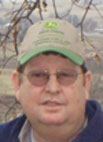 Ralph Moore, of Lincoln, Ark., has spent the better part of his adult life around Simmental cattle. And that’s just how he wants it to be.
Ralph Moore, of Lincoln, Ark., has spent the better part of his adult life around Simmental cattle. And that’s just how he wants it to be.
Ralph and his wife, Reba, raised their three children on the farm they own, that was originally Ralph’s grandfather’s place. Ralph and Reba’s sons, Allen and Curtis, (pictured at right), in addition to their daughter Denise, all grew up in 4-H and FFA, showing the family’s preferred breed – Simmental cattle.
Ralph served as President of the Arkansas Simmental Association for six years, and loved every minute of it. In addition to taking their own kids to national and regional shows, Ralph and Reba usually had a few other kids from the Association with them, crisscrossing the country to compete. Things have slowed down a bit, now that all three kids are grown, but the third generation of Moores is coming up quickly. Reba and Ralph look forward to the day that they’re again driving to a National show, only this time, they’ll be content to sit back in a chair and keep an eye on the cattle.
Work and play on the Moore farm revolves around Simmental. “We’ve even taken our cows to the capital,” smiled Reba, adding, “We wanted to go to the state capital, because you drive right by it going to the state fair. So we took “Red Doll,” a big, solid Simmental heifer to see it with us. All of our vacations have been Simmental National and Regional shows.”
Simmental is a breed that the Moore’s are enthusiastic about promoting. Simmental is one of the oldest and most widely distributed of all the cattle breeds. The first herd book was established in Switzerland in 1806. In those early years of the breed, the then red and white animals were sought out because of their rapid development, outstanding milk production and their use as draft animals. Reba said she prefers the “old style” colored Simmental, and is always first to lay claim to calves with the original coloration, although the Moores primarily have black cattle now.
The Moores see their breed’s adaptability as a key to its success. The cattle industry today gravitates toward black cattle, and Simmental has responded to that with a Black Simmental and a few other variations.
“We had one of the largest black Simmental herds in the 1990’s, and they just tend to bring better prices,” said Ralph.
In addition to the Simmental, Ralph also has a herd of commercial cattle. During the day, he can be found working with his brothers as part of Moore Brother’s Septic.
Staying on top of the market trends and keeping costs low is what Ralph and Reba strive for in their operation. Feeding corn silage has been a big help in their efforts to meet this goal. They’ve found that growing corn on their 400 acres of rented and owned land is the key. Their son Allen has a custom chopping business, and helps out with the silage. Mixing the silage with hay in a pit built specifically for it, has lowered their feeding costs dramatically, and they’ve seen a big payback in lowered feed costs.
Promoting Simmental cattle and using innovative management practices at the farm is all in the plan for Ralph. He and Reba are exactly where they want to be – in close proximity to their cattle.







